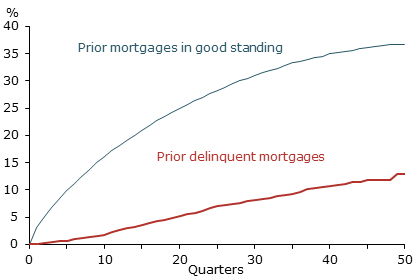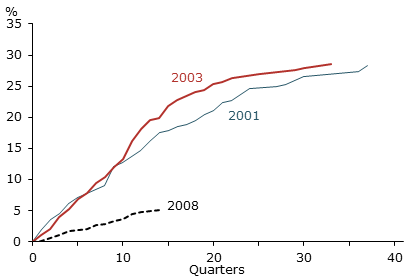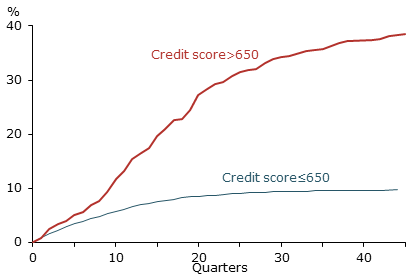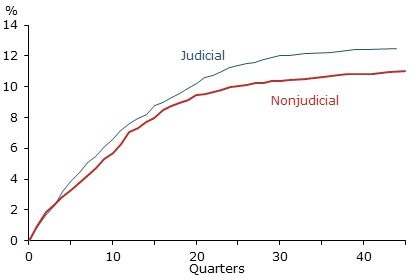Borrowers who default on mortgages return to the mortgage market at extremely slow rates. Only about 10% of borrowers with a prior serious delinquency regain access to the mortgage market within 10 years of their default. Borrowers who terminate mortgages for reasons other than default return to the market about two-and-a-half times faster than those who default. Renewed access to credit takes even longer for subprime borrowers with a serious delinquency on their record.
Historically, the U.S. mortgage default rate has varied in the range of 0–2% over the economic cycle. However, default rates broke dramatically from this historical pattern in 2006. At the peak of the housing downturn, the aggregate default rate climbed to about 10% of mortgages. In certain geographical markets and for certain types of mortgages, such as loans to subprime borrowers, the rate exceeded 25%.
What happened to borrowers who defaulted? On the plus side, defaulting borrowers potentially got some financial breathing room. Housing expenditures are typically about 30–35% of total household income. For many overstretched borrowers, defaulting on a mortgage and becoming a renter reduced housing expenditures considerably, although the quality of their living quarters was lower. Furthermore, the extended period between mortgage default and foreclosure allowed many borrowers to remain in their homes for a while rent-free.
Of course, foreclosure is far from a positive for most borrowers. One need only look at the estimated home equity of U.S. households to realize that borrowers perceive default to be very costly. The share of homeowners with mortgage balances exceeding the value of their houses is estimated to be about 20%. Many of these underwater borrowers appear to have a financial incentive to default. The fact that most do not default suggests borrowers see other costs to walking away from their mortgages.
One of the main costs is that access to credit is restricted for borrowers who have defaulted. Relatively little research has examined how default affects borrowers. Cohen-Cole, Duygan-Bump, and Montriol (2009) find that certain provisions in the bankruptcy code allow borrowers who have defaulted on a mortgage to get credit cards again fairly rapidly. For mortgage borrowers, Brevoort and Cooper (2011) find that those who went through a foreclosure in the recent housing crisis experienced sharp drops in their credit scores, which appear to be long lasting. Moreover, these borrowers are more likely to default on other types of debt.
Borrower access to credit markets following a mortgage default
In this Economic Letter, we examine how long it takes individuals or a household to borrow again to buy a home after defaulting on a mortgage. To get a sense of how default affects access to mortgage markets, we look at consumer loan data from the first quarter of 1999 to the fourth quarter of 2011 collected by Equifax, a major credit reporting agency. Our analysis is based on Equifax data in the New York Federal Reserve Bank’s consumer loan file, a 5% nationally representative random sample designed to reproduce the movement of young and old consumers into and out of the credit pool (for a description, see Lee and Van der Klaauw 2010). We define default as a mortgage that terminates when, in the final quarter it is observed, it is either 120 days past due or severely derogatory, meaning it is past due and reported to have a charge-off or foreclosure.
We treat access to credit as a decision more or less made by lenders. In other words, at what point are they willing to lend again to a borrower with a tarnished history? In reality, borrowers may not want credit. The data only show the quantity of credit outstanding. They do not directly indicate credit demand or supply, although some inferences regarding credit supply can be made.
In addition, important institutional restrictions affect credit following mortgage default or foreclosure, especially mortgage borrowing. People with a major derogatory event on their credit history, such as foreclosure or bankruptcy, typically can’t qualify for a conventional loan securitized through government-sponsored enterprises (GSEs) such as Fannie Mae and Freddie Mac until four to seven years have elapsed, depending on circumstances surrounding the event. This restriction does not completely preclude lending to borrowers who have recently defaulted. A lender has the option of making the loan and keeping it on its own balance sheet instead of selling it to one of the GSEs. However, the GSEs own or guarantee the vast majority of new mortgages, which makes the restriction a powerful barrier keeping defaulters from returning to the market.
Figure 1
Cumulative rate of return to mortgage market

Source: FRBNY Consumer Credit Panel/Equifax and author’s calculations.
The Equifax data confirm that a prior mortgage default has a large effect on future access to mortgage credit. Figure 1 shows the rate at which borrowers with different credit histories return to the mortgage market following a termination or exit. Termination is defined as having a zero mortgage balance after having a positive mortgage balance.
The blue line in Figure 1 plots the rate for returning to the mortgage market for borrowers with no prior defaults or foreclosures. We do not know why these borrowers terminated their mortgages. They could have moved, or adjusted their housing expenditures by trading up or downsizing. Or they could have paid down their mortgages and now own their houses outright. We might expect that most borrowers who have paid off their mortgages will never return to the market. Indeed, 12 years after a termination, just above 35% of borrowers with no prior defaults have taken out new mortgages. This number may seem low. But, as the red line in Figure 1 shows, it is much higher than the average rate at which borrowers with prior defaults return to the mortgage market over the same time horizon.
Figure 2
Return to mortgage market following defaults

Note: Cumulative rate, variation by default vintage.
Source: FRBNY Consumer Credit Panel/Equifax and author’s calculations.
Figure 2 shows the rates at which borrowers who defaulted on mortgages in 2001, 2003, or 2008 returned to the market. The figure plots the cumulative percentage of defaulters who have a new mortgage within a given number of quarters after their last default. Even though a short amount of time has passed since the 2008 cohort defaulted, their return to the housing market appears to be significantly slower than for cohorts that defaulted in the two earlier years. The low rate of return for the 2008 cohort could be related to demand. In the 2001 and 2003 cohorts, there was very strong overall demand for housing, as evidenced by the strong run-up in the rate of homeownership during the 2000s. But the Great Recession that began in 2007 was much deeper than the 2001 recession, and uncertainty about jobs or future income prospects may have made people unwilling or unable to demand housing at the rate seen after previous recessions.
However, the 2008 cohort’s slow return to the mortgage market could also reflect tight credit supply. The mortgage finance system was severely disrupted during the financial crisis of 2007–08. The 2009 and 2010 mortgage default cohorts look very similar to the 2008 group, although they are not shown in Figure 2. By contrast, the credit environment for the 2001 and 2003 cohorts was very different in the years after their defaults. Loan terms were generally easy and subprime mortgage lending boomed.
Figure 3
Return to mortgage market by initial credit score

Source: FRBNY Consumer Credit Panel/Equifax and author’s calculations.
Economic growth was solid and interest rates low in the decade following the 2001 recession. But Figure 2 shows that, even in these good times, it took a long time for defaulted borrowers to return to the housing market. About two-thirds of the borrowers in the 2001 cohort had still not come back within 10 years.
Figure 3 shows the rates of return to the mortgage market according to the borrower’s initial credit score. Borrowers who defaulted in any year within the sample are included and are divided into two groups: those with credit scores above 650, labeled prime, and those with scores of 650 and below, labeled subprime. The credit scores used are borrowers’ first scores after taking out mortgages on which they eventually defaulted.
Figure 4
Return to mortgage market by type of foreclosure

Source: FRBNY Consumer Credit Panel/Equifax and author’s calculations.
Interestingly, the experiences of the subprime and prime groups in the two years following foreclosure are similar. This is probably because the borrowers we label as prime are no longer in that category after foreclosure. Indeed, Brevoort and Cooper (2010) show that, regardless of pre-foreclosure credit score, the typical borrower who goes through foreclosure ends up with a credit score below 600. Figure 3 also shows that, after about two years, borrowers who were in the prime group before foreclosure begin to return to the mortgage market at significantly faster rates than those in the subprime cohort. All the same, the majority of prime borrowers do not return to the mortgage market within our sample period.
Are there important differences in the rate of return to the mortgage market across different types of markets? Figure 4 shows that one distinction that does not appear to matter much is the type of foreclosure law, that is, whether the borrower lives in a judicial or nonjudicial foreclosure state. This is surprising. Judicial foreclosures, in which the foreclosure must be pursued through the courts, are much more time-consuming and costly than nonjudicial foreclosures, in which the lender can serve the borrower with a notice of foreclosure and proceed to reclaim the house. All else equal, borrowers in judicial foreclosure states would be expected to be denied credit for longer periods.
What explains the timing of the return to the mortgage market?
The rate at which borrowers get new mortgages after defaulting on a mortgage is low. Only 30% of borrowers who defaulted in 2001 had taken out another mortgage within 10 years. What explains the pace of return to the mortgage market? Overall economic conditions appear to play an important role in allowing borrowers who have defaulted to return to the market. When we control for factors such as local unemployment rates and past house price appreciation, we find that these variables influence the rate at which defaulters come back to the mortgage market. Overwhelmingly though, the best predictor of when a defaulting borrower returns to the market is the change in the borrower’s credit score. Our research finds that, after five years, borrowers who return to the mortgage market after a default have experienced a more-than-100 point increase in their score.
Conclusion
Evidence suggests that the process of regaining creditworthiness is lengthy. Borrowers who terminated their mortgages for reasons other than default returned to the market about two-and-a-half times faster than those who defaulted. This has important implications for the housing recovery. The improvement in the housing market is often assumed to reflect significant pent-up demand. But an estimated 4 million foreclosures have taken place since 2007. The consumers who went through those foreclosures will return to homeownership only gradually, suggesting that mortgage supply will also be a factor in the housing recovery.
References
Brevoort, Kenneth P., and Cheryl R. Cooper. 2010. “Foreclosure’s Wake: The Credit Experiences of Individuals Following Foreclosure.” Board of Governors Finance and Economics Discussion Series 2010-59.
Cohen-Cole, Ethan, Burcu Duygan-Bump, and Judit Montriol. 2009. “Forgive and Forget. Who Gets Credit After Bankruptcy and Why?” FRB Boston Quantitative Analysis Unit Working Paper 2009-2.
Lee, Donghoon, and Wilbert Van der Klaauw. 2010. “An Introduction to the FRBNY Consumer Credit Panel.” FRB New York Staff Report 479.
Opinions expressed in FRBSF Economic Letter do not necessarily reflect the views of the management of the Federal Reserve Bank of San Francisco or of the Board of Governors of the Federal Reserve System. This publication is edited by Anita Todd and Karen Barnes. Permission to reprint portions of articles or whole articles must be obtained in writing. Please send editorial comments and requests for reprint permission to research.library@sf.frb.org